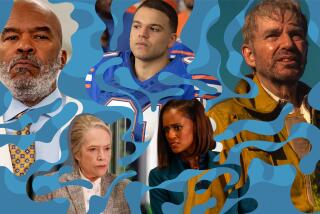Broadcast: Paradox of the Term
- Share via
Network television viewing has historically been cyclical. Sitcoms were written off in the early 1980s, before “The Cosby Show” took the nation by storm. A decade later, “ER” came along, propelling drama back to the top of the ratings.
While some cling to the idea that television merely needs to generate more hit shows, what if the funk the major networks are in doesn’t represent a cycle, but rather a fundamental shift--a change from broadcasting in its truest sense (putting on programs with something for everybody) to narrowcasting, targeting more focused segments of the audience?
John Wells, for one, thinks programs that assemble 30 million people each week, as “ER” does, may not happen again--a sobering observation coming from the executive producer of “ER,” one of the last remnants of the mega-hit and still network TV’s most potent ratings medicine for the creeping disease of viewer erosion.
“We’re in a world where we’re going to increasingly be gearing what we’re doing to very specific audiences, with different kinds of expectations as to what’s perceived to be a success,” Wells said, sitting in his Burbank office.
Wells isn’t alone in stating that the TV industry can no longer blithely go forward in business-as-usual fashion. Others agree that the emphasis on tracking network ratings declines overlooks more serious issues.
“It’s dangerous times,” said Michael Pressman, a producer and director whose credits include the much-honored David E. Kelley series “Picket Fences” and “Chicago Hope.” “I think they’ve misdiagnosed the problem. The focus is on the numbers, and not the content of the material.”
In a 1991 interview, the late Brandon Tartikoff--preparing to segue from the top programming job at NBC to Paramount Pictures--seized on the concept of broadcasting heading inexorably toward narrowcasting, suggesting every program should be someone’s favorite show.
The networks, Tartikoff told The Times’ Rick Du Brow, must take “a more visionary shot. . . . Do something that’s totally different, that’s not on cable, not on your competitors. You get a nucleus of viewers that you can build on.”
Wells concurs, saying the key for any TV series going forward must be that “people are going to be desperately unhappy if it’s not on the air. . . . It can be a relatively limited core, but if you’ve identified it, and you can sell it to advertisers, that’s a successful series.”
Wells acknowledges that he surveys the situation from a rare position of privilege, as a writer-producer who has benefited mightily from the current system, despite his recent experience with “Trinity,” a new ensemble drama that NBC shelved last week--at least temporarily--after just four telecasts.
Perhaps the biggest hurdle to overcome, Wells said, is for networks to admit they can no longer bank on broadcasting in the traditional sense.
“We’ve all been dancing around it,” he noted. “The networks are loathe to actually begin talking about narrowcasting because the perception within the broader investment community is that’s an admission of failure, which I think has made the conversation difficult. . . . It’s not in anybody’s best business interests to yet pronounce it dead.
“The problem is we’re all still holding on to [what was]. Look, it’s a lot of fun to wake up on Friday morning, call NBC and hear there was a 40 share [of audience] on ‘ER’--particularly when you’ve spent a lot of years in television laboring on shows that haven’t worked, and some that have but weren’t nearly that successful.”
In a sense, Wells’ view extrapolates from where the television world is now. Specific audience segments--men, women, children, even cooking buffs--are already being skimmed off by cable networks such as, in sequence, ESPN, Lifetime, Nickelodeon and the Food Network.
The day when networks concede they must retreat to some modified version of at least narrower-casting, however, raises several intriguing questions, starting with what effect that could have on both programming and society.
Creatively, Wells maintains, “it will ultimately be liberating. . . . If we’re freed of some of the broader notions of what broadcasting should be in storytelling, what comes out of it? I think if you look at the WB as an example, some pretty exciting things come out of it, because you know what you want to write, and you know sort of generally a viewpoint, a time of life, you want to work toward. Then you craft it, and you get better work doing it.
“It gives you an opportunity to create shows that aren’t as homogenous, because you’re not trying to say, ‘Well, how do we get the parents to watch?’ Sometimes, trying to do those viewpoints are very difficult.”
A more profound question involves whether society loses something when there are no longer collective experiences like the first moon walk (Neil Armstrong’s, not Michael Jackson’s) or “Roots,” which millions of people watched simultaneously and discussed the next day.
Wells thinks there will still be “water-cooler experiences” for big media or news events, but not in entertainment; instead, people will form smaller communities, sharing “Dawson’s Creek” (a hit among teenagers) or “Party of Five” (which primarily plays to young-adult women) within their own peer groups.
Indeed, in today’s frenetically paced media environment, family members increasingly scatter to watch programs or surf the Internet in different rooms, reducing the odds anyone has seen the same show viewed by a neighbor they encounter in the driveway or co-worker they see the next morning.
If you accept these dynamics, then networks and producers must adapt to meet them. Broadcasters can no longer “throw a bunch of stuff at the wall,” as Wells put it, to see what sticks, but must tailor shows for specific needs. Producers must be honest about what they’re willing to supply, and make deals with the network where their concept has the best chance to work, not whoever’s desperately throwing around the most money.
That will require suppressing egos and getting beyond what Wells called “the horse race part of the business”--the deeply ingrained competitive spirit.
“We’ve all been talking for a lot of years, saying that this was coming. It’s one thing to say it’s coming and another to look around and say, ‘Wow, it’s here,’ ” Wells said. “That year of ‘ER’ and ‘Friends,’ we didn’t know it at the time, but if we had been conscious of it, we would have felt the wind from the door slamming up against our backsides as we came through it.”
More to Read
The complete guide to home viewing
Get Screen Gab for everything about the TV shows and streaming movies everyone’s talking about.
You may occasionally receive promotional content from the Los Angeles Times.






